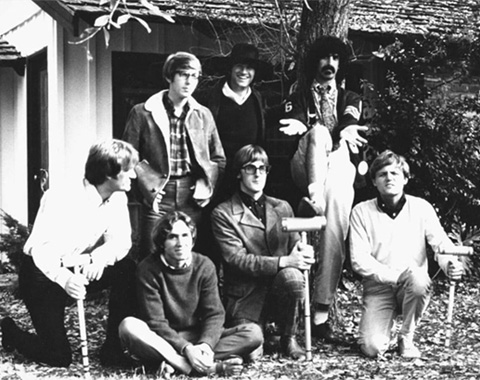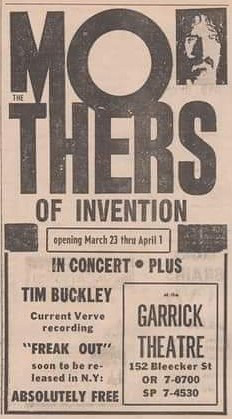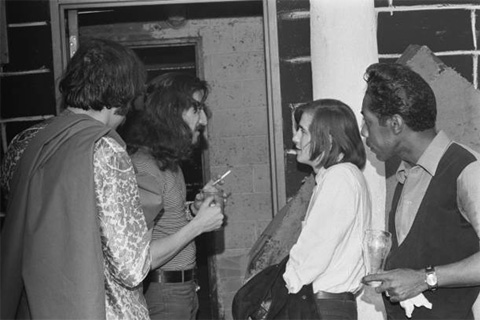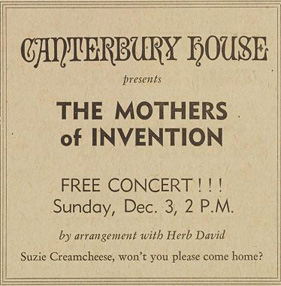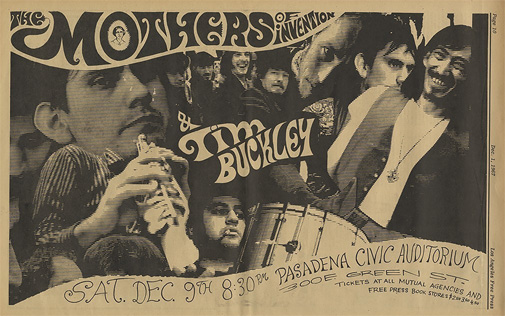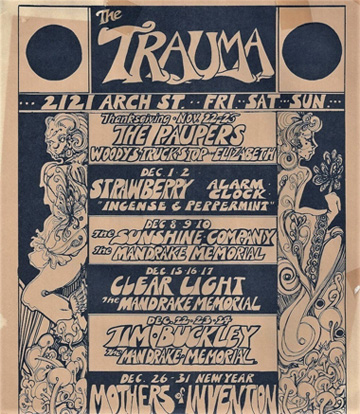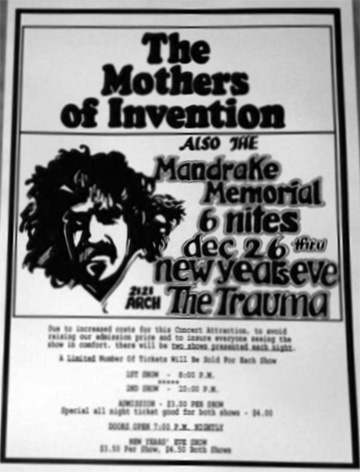January 7-21, 1967—The New Penelope, Montreal, Canada
McGill Daily, January 13, 1967, p. 12
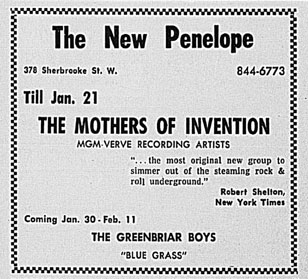
Mari Oliensis, "The Mothers Of Invention," McGill Daily, January 13, 1967, p. 12
The time schemes and tonal patterns used are at least as comlex as anything classical Western music has produced and take an experienced, competent musician to handle properly. All the members are skilled if not spectacular, and most of them have had much experience in other musical fields. Perhaps the best musician, in the traditional sense, was "Bunk" Gardner (electric flute, sax, oboe, bassoon, etc) with 15 years of classical training. Roy Estrada plays a substantial, flashy bass guitar.
Much of the woodwind work, almost all the vocal parts and many anonymous details (which might have been important to their composer) were lost in an overwhelming mass of rhythm and tympany. Partly because of the very unsuitable acoustics of the New Penelope, it also reflected a rigidity alien to good music in this field. Zappa may rehearse the Mothers five hours a day and produce good technicians, but he cannot force sensitivity among members of a group which have been together as such less than four months. Instead of supporting the lead instrumentalist on his break, the rhythm patterns are maintained in a hypnotic and mechanical fashion. Either that, or he is forcing sensitivity out of them to produce his own music, having both "ferocity and finesse" (Gardner) but no longer a spontaneous group expression.
McGill Daily, January 13, 1967, p. 2
Radio McGill
CFQR-fm 92.5 mcs
10 pm
These three in perspective
Once again, Brian Gilhouly and alan Goldbloom present an in-depth analysis of the week's news, featuring exclusive interviews with Dr. Mordecai Kaplan and the Mothers of Invention.
The eight-man group, led by Frank Zappa, a 26-year-old composer [...], is currently appearing here.
[...] The larger than usual rock group uses a wide range of instruments. Besides two sets of standard drums and the usual electric guitars, the Mothers of Invention manipulate kettle drums, something that looks like an electric piccolo, an electric clavichord, an electric bassoon, flutes, saxophones, tongs and a finely tuned truck spring.
[...] Picking out the delicate but frank subtleties, can be an enrapturing experience. The three guitars, for example, create a transcendant quality which, if listened to inattentively, suggests they are playing three different songs.
Some of the lyrics are equally fascinating ("Go ahead and scratch your pie, I don't love you any more.")
Listening to the Mothers is an adventure. It takes a few hours for the sound to get out of your ears after leaving the New Penelope.
[...] In effect, Zappa has become a sort of Marshall McLuhan of the rock scene. And like McLuhan, even he is not quite sure what the electronic message is all about.
"In fact," he says. "We're not even sure who plays the drums."
Juan Rodriguez, "Mothers Of Invention Here At New Penelope," The Georgian, January 13, 1967
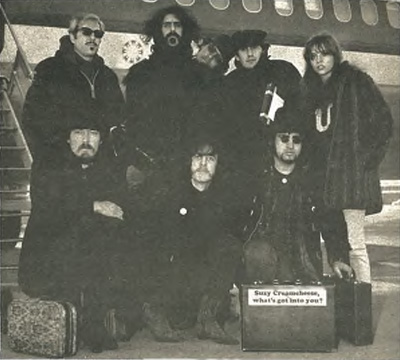
[Bunk Gardner, FZ, Don Preston, Roy Estrada, Gail Zappa; Ray Collins, Jim Fielder, Billy Mundi (missing: JCB)]
The Mothers of Invention [are] currently playing out a two-week engagement at the New Penelope [...]. Montreal represents the second leg on their first journey east; the Los Angeles group had just completed a successful run at New York's Balloon Farm prior to coming here. [...] Their first record, a big package deal called Freak Out! (MGM-Verve) is selling like hotcakes; at last count 80,000 have been sold, which is amazing for an "underground" group that has never had a single released yet.
[...] There are eight Mothers, and they play a variety of instruments including electric guitars, bass, drums, timpani, bassoon, sax, electric flute, electric piano and organ, bells, "mouth", and tambourine. [...] In one song they start by lampooning the Supremes' "Baby Love"; then, halfway through they ditch Motown and "swing" in to Stravinsky. Another number, "Electric Banana", is a marvellous piece of music: It is neither classical nor jazz nor rock—perhaps a bit of each—and it is unlike anything you have ever heard. [...]
[FZ] then turned to the relationship between pop music and art. "It's always occured to me that music should be approached as an art form. I don't see many people in the pop field doing this—perhaps the Beatles & their arranger George Martin and Hal David & Burt Bacharach—and this is disappointing. If you're not approaching music as an art then you might as well go back to plumbing. Why does pop music have to be bad?"
[...] Their gags and parodies (Zappa wears a button that says "Folk You") are lots of fun, but it is their music that will stun you. The Mothers of Invention Will be at the New Penelope until January 21; I recommend them without reservation.
LR: Is it true that Zappa, halfway into the job, suggested changes . . .
FD: That, I have no memory of . . .
LR: Gary supposedly said "Oh! Well when they came to set up their equipment—because they were playing there for two weeks anyway—not just a one-nighter—He said: "no, no, gotta change that, that and that." Now, I don't know if he was talking about sound equipment of the way the stage was set-up and all that . . .
FD: No, I would think that, with regards to re-setting the layout that could be done for sure. There was a lot of flexibility in that. So, regarding that, no problem. So changes were only for the sound system, to avoid reverberations.
FD: As you recall, this wasn't an enormous contract. It had to be done on a shoe-string budget. Was that the reason for having wooden benches and scaffolding or scaffolding style?
FD: No, it was really because he didn't have a lot of money, so I opted for that sort of system, a simple system of bleachers. A very simple system of scaffolding that could be set-up, taken apart, and a totally flexible lighting system, with classic, traditional lighting [ACTUAL MECHANIC LIGHTS].
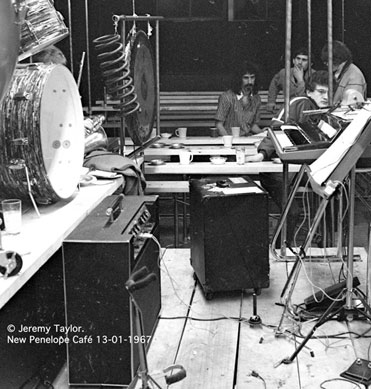
© Jeremy Taylor. New Penelope Café 13-01-1967
LR: Did you have the opportunity to see Frank Zappa during those first shows, just to see how it all worked out?
FD: Yes, I saw all that, but I don't really have any recollections of that. In that era, Zappa mingled with everybody, young people, etc . . . and me, I was with my girlfriend and would just relax.

© Jeremy Taylor. New Penelope Café 13-01-1967
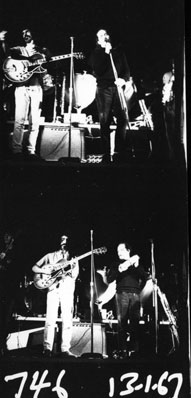
[Jim Fielder, FZ, Ray Collins]
We played everywhere. Like the time we spent in Montreal, when we played a club called the New Penelope and it was twenty degrees below zero. We walked from our hotel to the club, and the snot had literally frozen in our noses by the time we got to work. The wind instruments got so cold that if you tried to play them, your lips and fingers would freeze to them. The instruments couldn't even be played until they were warmed up. It was pretty primitive. If we hadn't experienced that, we probably wouldn't have come up with some of the more deranged types of audience participation and audience punishment things that we were doing at the time.
The club was called the New Penelope. The owner had come down to the Balloon Farm to see us play and hired us for the two weeks up there. [...]
We also did some recording for the Canadian Film Board while we were there. I think it was for a movie or documentary.
After we finished in Montreal and flew back to L.A., Jim Fielder left the band—he hadn't been too happy playing second guitar.
Informant: Denis Griffin
April 6-19, 1967—The Garrick Theatre
Thursday, April 6—Wednesday, April 19, 1967: The Mothers Of Invention
Shows were held at the Garrick Theatre, upstairs the Café au Go Go.
April 10, 1967—Easter Sunday—The Garrick Theatre
The Mothers of Invention played the Garrick Theatre in New York for six months, two shows a night, six nights a week and on Fridays and Saturdays we would do three shows a night. In order to keep from getting totally bored of playing this place, we started to get theatrical . . .
The Mothers' extended New York stay at the Garrick Theatre in 1967 was one such jolt. Like a drop kick in the crotch, the band hit New York with two shows a night, six nights a week for six months with Zappa's freewheeling soundtrack for the Great American Abomination. Zappa explains that the Mothers first went to New York because they were literally kicked out of Los Angeles. This was the time of the Sunset Strip riots, when property owners along the Strip attributed falling real estate values to bands of freaks cruising up and down Sunset Boulevard and got City Hall to do something about it.
"The net result was illegal police roundups, with no warrants, of people on the street. They'd show up with a bus and just herd 20 or 30 people in a bus, arrest them, take them downtown, and let 'em go. It was pure harassment."
Subsequently, Sunset Strip clubs stopped booking the bands which attracted the crowds, the scene dried up faster than a prune in the sun, and the Mothers tried New York as an alternative. After a pair of gigs at the old Balloon Farm off St. Mark's Place, the band happened on the 300-seat Garrick Theatre, moving in for a two-week Easter vacation gig in '67. The Garrick shows—originally titled "Pigs and Repugnant," later changed to "Absolutely Free"—did turn away business for those first two weeks. Flushed with success, Zappa decided to stick around, snaring a lease at the Garrick through Labor Day in the hope that the rest of New York was dying to witness the Mothers mixmaster their own unique combination of metaphorical stage violence, Top 40 avant-garde sounds, and underground rock oratorios.
"Of course, after Easter vacation, the crowds dwindled to zilch. Some nights there were three, maybe five people in there and we'd still play. But we would do it just for them. In fact, there was one night when there were just a few people in the audience. Now the Garrick Theatre was located right above the Cafe Au-Go-Go and there was a connecting passageway down to the Au-Go-Go. So all the guys in the band went downstairs and got some hot cider and coffee and stuff, put little napkins over their arms, and each guy in the band went up, sat down next to each person and served them a drink, talking with them for an hour-and-a-half. That was the entire show."
All the students were out of school, because of the Easter holidays and were coming into the city. There were lines of people wanting to get in and sometimes, especially on the weekends, we were having to play three shows a night because the theater only seated about 250 people. Richie Havens would open for us and play about 35 minutes and then we'd play for about one hour. They would empty the theater out after the first show and there would be about a thirty-minute intermission. Then Richie would start playing all over again and on and on. It was $3 admission on a weekend and I think $2 during the week. Some guys would get in line and buy tickets again—it seemed to me that they couldn't get enough of us.
Right after Easter, we shut down the theater for one night and took a bus to the University Of Maryland to play an audition for the college circuit.
Eventually, we would get some good work out of it because later on we played Princeton, Colgate and Harvard Colleges. During the Garrick run, we'd close for the occasional night and would go and play one of those gigs.
After we had done the Easter run is when Frank and Herb decided, "Well, if it's going this well, let's do an extended run for as long as we can do it!"
[...] We had all been staying at the Hotel Albert but now we all started looking for flats, which in New York City are not easy to find. [...] Bunk, Don and Roy got a flat together.
Dick Barber and Bobby Zappa came out from L.A. to join us after we had decided that we were going to make the Garrick Theater our base for a while. Bobby was responsible for taking the money at the ticket booth and Dick became kind of like the road manager, like the bouncer, like the gofer. [...]
After we had decided to stay on, Frank started changing the arrangements to some of the songs and we started to improvise a lot more too. That would be about the time that we started doing a lot more of the extended things like "King Kong."
Frank persuaded me to go down and buy a trumpet. I hadn't played it for many years but I got my "chops" sort of back. I bought a bass trumpet because it was easier to play and had a bigger mouthpiece.
May 24-September 5, 1967—The Garrick Theatre
May 24, 1967—Absolutely Freeee Opening
Wednesday, May 24—Wednesday, May 31, 1967: The Mothers Of Invention
Shows were held at the Garrick Theatre, upstairs the Café au Go Go.

Dan Sullivan, The New York Times, May 25, 1967
"ABSOLUTELY FREEEE," which opened at the Garrick Theater last night, will cost you threeee dollars a ticket. Whether you find the money well-spent will depend a great deal on how old you are, or wish you were.
Although a good many strange and wonderful things were promised by the advance publicity for this show under its former name, "Pigs and Repugnant," it turns out to be nothing more nor less than a concert by a seven-man group called The Mothers of Invention.
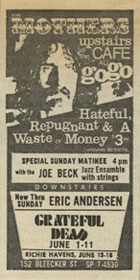
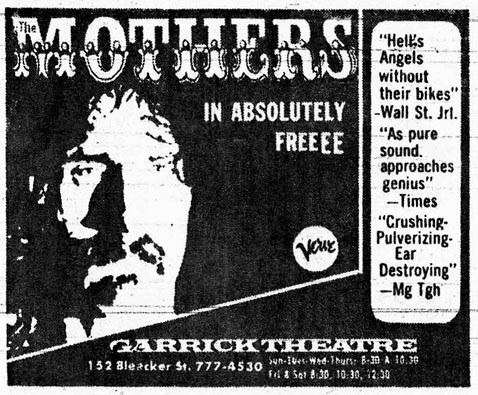
c. May 1967—The Turtles in New York City
We pulled into New York City [...]. On our nights off, or even after our shows, the whole group would head off to Greenwich Village to hang with the hippies and smoke pot in Washington Square. Our pals from L.A., the Mothers of Invention, were playing ridiculous shows at the Garrick Theatre, and we'd hang there night after night.
May ?, 1967: 'Ed Sullivan Show', CBS TV Show, Ed Sullivan Theatre, Broadway, New York City, NY (filming date)
[...] May 27-30, 1967: The Steel Pier resort, Atlantic City, NJ
May 2?, 1967: 'Clay Cole's Diskotek', WPIX Channel 11, unknown television studio, New York City, NY with Paul Anka, Frankie Valli, Every Mother's Son, Chad & Jeremy, The Shirrells (filming date....the show was broadcast on June 3)
June 1-30, 1967—The Garrick Theatre
Thursday, June 1—Friday, June 30, 1967: The Mothers Of Invention, Eric Andersen (4 only), Luke and The Apostles (4 only)
Shows were held at the Garrick Theatre, upstairs the Café au Go Go.
June 6-11, 1967—Grateful Dead & The Mothers
Rock Scully and David Dalton, Living With The Dead, 1996, pp. 95-96
While in New York we play the Cafe' Au Go-Go. Zappa's group is there too, they have this glorious room upstairs and we are down in the basement in a long narrow room with a brick wall right in front of us. There's nothing worse than a full electric band blaring up against a brick wall. At the sound check we despair, but when the place fills up, the audience soaks up the sound and it becomes bearable. However, the racket from that wall is so loud it bounces all the way up the stairs. Frank Zappa complains! Turn it down! But our audience wants it turned up. We are forced to stagger our sets.
Zappa is a jerk about the whole thing. Instead of coming down himself, he gets the manager and demands we turn our amps down. He has top billing! Later on I come to dig his music., but at the time I think this guy is a phony and no good to boot (not that we're much better). [...]
People think Zappa is so hip he must be high on acid (he contributed to this illusion by calling his first album The Mothers of Invention Freak Out), but he's actually vehemently antidrug, not only in regard to himself but toward everybody else in his band as well.
Zappa warns them not to hang out with the Grateful Dead. He sniffs their clothes like a custom's dog. And these are Latinos from East L.A., very funny guys who talk like Cheech Marin. We're in the same hotel and we're up all night smoking, half of them have passed out, and when the phone rings they hide under the bed.
"Don't answer it maaan, if he finds us here we got to rehearse extra!"
At least that's one problem we don't have!
Billboard, June 17, 1967
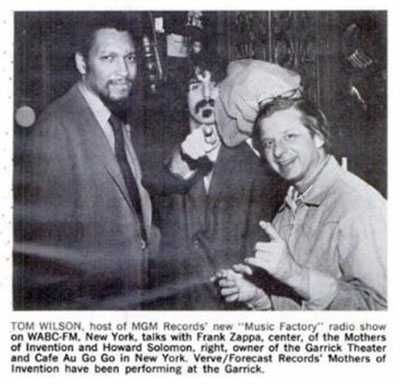
TOM WILSON, host of MGM Records' new "Music Factory" radio show on WABC-FM, New York, talks with Frank Zappa, center, of the Mothers of Invention and Howard Solomon, right, owner of the Garrick Theater and Cafe Au Go Go in New York. Verve/Forecast Records' Mothers of Invention have been performing at the Garrick.
June 10, 1967—Garrick Theatre
Sal Lombardo
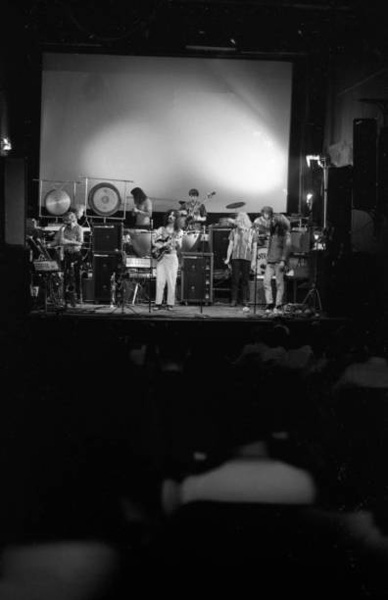
[Bunk Gardner, Don Preston, JCB, FZ, Roy Estrada, Ray Collins, Billy Mundi, Sal Lombardo.]
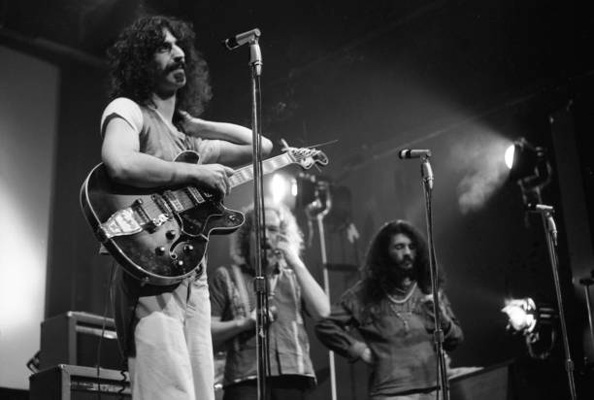
[FZ, Ray Collins, Sal Lombardo.]
[...] "Frank Zappa & The Mothers of Invention" performing on stage at the Garrick Theatre on June 10, 1967 in New York. (Photo by Don Paulsen/Michael Ochs Archives/Getty Images)
New York weather in the summertime is pretty disgusting. Sometime around the
first of June, the air conditioner died and the owner of the theater (David
Lee Roth's Dad, I'm told) decided that it would be too expensive to fix
it.
Picture a room like a long, narrow tunnel (actually, a former 'art movie' theater)
that holds three hundred people; easily 102 degrees at all times, totally humid,
and no air circulating.
[...] One day, on my way to lunch at the T.A., a guy wearing a buckskin suit—in
July—with a black scraggly beard and hair sticking out all over the place,
came up to me and said, "I want to be in your band."
"What do you play?" I asked. "Nothing," he
answered. "Okay," I said, "you've got the job." The guy's name was Sal Lombardo.
Later that night, I handed him some maracas and a tambourine—he didn't get
paid, but he got to stand onstage and 'be in the band.'
Part of our show included the concept of nightly 'enforced recreation' —sort of like audience participation, only more dangerous.
We'd be playing something and I'd lean over and say, "Sal, see that
guy over there? Go get him." Sal would then snatch the guy out of the
audience and drag him onstage. It was then my privilege to invent 'recreational
activities' for these hapless individuals, inducing them to 'participate.' You can see Sal in the video of Uncle Meat. He's the guy lying on
his back with a corncob in his mouth, having whipped cream squirted in his face
during 'Mr. Green Genes." That night his entire buckskin suit was covered
with real whipped cream. He never had it cleaned. Do you know what real
whipped cream smells like on BO buckskin at 100-plus degrees? We're talking bestiality here.
[...] The floor of that stage had a green rug on it. When we filmed the "Mr.
Green Genes" video, the people on stage had stomped a bunch of vegetables
and whipped cream into it, and it never got cleaned.
The stuffed giraffe and the other toys we used in the show lived in a box on
the side of the stage, along with chunks of dead vegetables. All organic matter
in the theater had begun to reproduce itself, and was producing 'a bad smell.'
Uncle Meat (1987) (approx. 0:35:04)
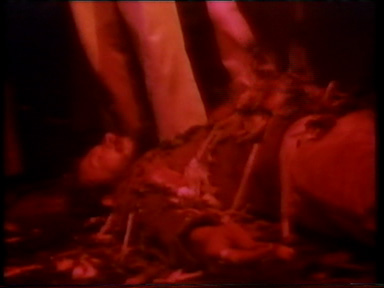
[Sal Lombardo.]
These three beautiful girls gave us this stuffed giraffe that was about three and a half feet tall. One day, out of boredom, Ray Collins and I wired that giraffe for the evening's performance, with a half inch clear plastic tube, running up its leg and right underneath its tail, which could be construed as the exit of the animal. We got behind the piano; the band were whipping into some frenzy. I was playing trumpet and drums and singing and going all over the stage at that time, so they didn't miss me and they didn't miss Ray. They were playing some instrumental. We got about ten cans of pressurised whipped cream from the Cafe-a-Go-Go, right down below the Garrick Theatre; real pressurised cans. We started squirting those cans down that tube from behind the piano, and they levelled the first three rows of the people in the studio. They had this white stuff, flying out of this giraffe's ass, hitting people in the face, and we sprayed at least five cans. People were splitting and Frank was on the ground. He had to stop playing he was laughing so hard. He'll never forget that one.
[...] The air conditioner broke down and for three weeks, six nights a week, in the middle of the Summer, in Greenwich Village, New York City, that theatre started getting rather rancid from all that whipped cream that was all over the place that they never bothered to clean up. The studio smelled like puke for three weeks, and pretty heavy duty puke. But yet, they still kept coming.
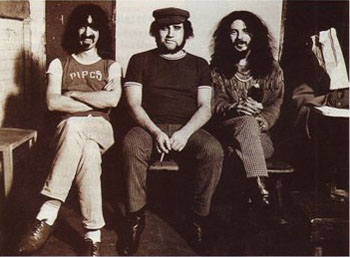
[FZ] with Billy Mundi and Sal Lombardo, backstage at Cafe Au Go Go, New York, 1967.
Photograph by David Gahr.
Additional informant: Javier Marcote.
Sandy Hurvitz aka Uncle Meat
Calvin Schenkel, Cal Schenkel Magazine, September 1981
I'm back in Philly. Had been since summer [1966], living in an old brick townhouse with Sandy [Hurvitz, aka Essra Mohawk]. She had had a few songs produced by Shadow Morton and was kind of a low key local success. Meanwhile the Mothers were in New York playing an extended gig at the Garrick Theater (a seedy little place over the Café a Go Go in Greenwich Village). Sandy went up one night and started singing with them. Motorhead nicknamed her "Uncle Meat" and she "joined the group" (for a couple of weeks).
I was visiting NY with two friends from LA that I had met in Philly when they came to see Cal Schenkel. We were walking down Bleeker Street in the Village when we saw Frank Zappa coming our way. He was headed towards the Garrick Theater, where he and the Mothers were playing every night. The LA girls yelled out, "Ben Frank's!, [Canter's]!", two popular hangs in LA that Frank was familiar with, so he let us all in for free and that's how we met!
[...] [Ray Collins is] who came up with the name 'Uncle Meat' at one of our rehearsals, telling Frank that he thought it was a great name for a rock star. Frank immediately spun around and pointing at me, he proclaimed, "You're Uncle Meat!"
[...] The song we began recording [for my album] was the one we performed every night at the Garrick: "Archgodliness Of Purpleful Magic." I can still remember Frank's guitar line [...]. It was quite an honour to have my song included in the Mothers' set. The only other song in the set not written by Frank, was a beautiful instrumental called "Epistle To Thomas" composed by keyboardist Don Preston in memory of his son who had died as an infant.
[...] It's because Don didn't feel well when the new keyboard arrived that Frank asked me to play it for him so he could hear how it sounded. The only music I knew how to play was my own. As I began playing, I started to sing along. That's all Frank had to hear. He instantly recruited me for the Mothers!
What [Essra] Mohawk came up with was due to a chance meeting with Frank Zappa
in 1967 in Greenwich Village. "Frank asked me to try out a new
electric piano he'd just purchased, as the Mothers of Invention's
keyboard player was ill. When Frank heard me play and sing my songs, he
hired me on the spot."
Mohawk became a Mother, performing as Uncle Meat. "One day at
rehearsal, Ray Collins, the Mothers' lead singer, said to Frank, 'How
about 'Uncle Meat' for the name of a rock star?' Frank spun around,
pointing at me, and announced, 'You're Uncle Meat!' "
Zappa started to produce her first album, Sandy's Album Is Here at
Last!, but she walked out of the studio when he "said something
that humiliated me." Zappa left the producer's chair. "We remained
friends long after the fact," she says, "but never discussed what
happened that ended up changing the course of my first album."
It begins with a medley of "My Boy friend's Back" ("a
rock-and-roll song which some of you may have gotten pregnant to"), followed by
"I'm Gonna Bust His Head," and "Ninety-six Tears." Ray is singing and
making literal, illustrative gestures. [...]
In the middle of the show Zappa introduces "this strange little
person in her mod clothes," who is called Uncle Meat. She is a very young,
expressionless girl with silky hair, who sings, sometimes in duet with Ray. They stand
with their arms around each other rubbing chests and looking tender and mournful. They
even dance with each other, separated by a century of style. Uncle Meat also gazes through
a kaleidoscope or rattles a hypnotic rhythm on the tambourine or parries Ray's carrot
swordplay using a lettuce leaf for a shield.
They are much more fun to watch than listen to, so that towards the
end, when they begin to tire and the singing becomes sporadic and the kidding around loses
its fervor, the music becomes relentless.
He calls his group "The Mothers of Invention," and the lineup looks like this: Frank Zappa, composer / arranger / conductor / guitar; Ray Collins, lungs / ingenuity; Bunk Gardner, piccolo / flute / clarinet / bass clarinet / bassoon / soprano sax / alto sax / tenor sax; Jim Black, percussion / bass trumpet / vocals & rain dance; Don Preston, piano / electric organ / organ / electric clavichord / bass clarinet / auxiliary percussion / nuclear effects; Ray Estrada, electric bass / arcane gestures; Billy Mundi, percussion /vocals / high-pitched noises. And a soulful little girl with tattered jeans who submits to being smeared with rotten oranges, being almost raped, and goosed into singing odd snatches of unintelligible lyrics; she goes by the name of Uncle Meat.
Sandy started to play with us a little bit. She was very young at the time and was still in her teens. She was given the stage name "Uncle Meat." She liked to hang with us quite a lot, especially with Don and Bunk!
Michael McCall, "Essra Mohawk, songwriter and former Zappa acolyte, gets the reissue treatment," NashvilleScene.com, February 25, 2010
Essra Mohawk first encountered Frank Zappa in 1967, walking down Bleecker Street in Manhattan's Greenwich Village. She was 19, visiting New York City from her home in Philadelphia with two female friends from Los Angeles. She loved Zappa's album Freak Out!, which had just been released, and when her friends spotted the lanky Zappa walking down the street with his trademark long curls, Fu Manchu moustache and soul patch, her friends started shouting out the names of L.A. locations where they'd seen him hanging out.
Zappa was on his way to the Garrick Theater, where his band, the Mothers of Invention, was amid a legendary six-month residency. "He let us in for free," recalls Mohawk, still known by her given name, Sandy Hurvitz, at the time. "We became fast friends. He started calling me 'the strange little person from Philadelphia.' "
[...] When Mohawk met Zappa, she'd already released a pop single, "The Boy With the Way" backed with "Memory of Your Voice" on Liberty Records at age 16. She'd been offered a songwriting contract by top music publisher Charles Koppleman, and she had been courted by producer Shadow Morton, who had provided her songs to the Shangri-Las ("I'll Never Learn") and Vanilla Fudge ("The Spell That Comes After").
After meeting Zappa, she left the pop world for something infinitely different. Not long after they met, Zappa ordered a new electric piano. The day it arrived, Mothers' keyboardist Don Preston was ill. Zappa remembered Mohawk played piano, so he set it up on the Garrick stage and asked her to test it.
"I started playing and singing one of my songs, and Frank jumped up and put a microphone in front of me," she says. "Then he jumped back into the theater and listened for a bit. Then he jumped back onstage and said, 'Step into my office.' He walked over to the second row of seats and pointed, so I sat down. He looked at me and said, 'How would you like to be a Mother?' "
Playing solo on piano, Mohawk began opening shows for the Mothers of Invention, staying onstage to sing harmony during the band's set. Zappa had her sing her own song, "Archgodliness of Purplefull Magic," during the band's set, only one of two non-Zappa songs featured during the Mothers' concerts in the year-and-a-half Mohawk performed with the band.
"The first band I was in was my favorite band," she says. "I have to say, it's been all downhill from there!" She then cracks up, leaning forward as she guffaws in her high, childlike tone, showing no bitterness.
I believe it was 1967 when we met. Essra has been my name since 1968 . . . my name was still Sandy [Hurvitz] when Keith [Reid] and I met. "'Uncle Meat' days": that's what Frank Zappa called me when I used to perform with his band, the Mothers of Invention, back then. Not only did I sing with the Mothers every night at the Garrick Theatre, but I also opened to them singing my own songs, playing the piano. The Garrick and the Café a Go-Go were in the same building and the owner, Howie [Solomon] had me opening to whoever was playing there as well. Due to this arrangement, I was often performing nine sets a night.
I opened to Procol Harum when they played the Café a Go-Go. I believe it was their first gig in the US!
Cal Schenkel & Bob Zappa
During the time we lived in the Thompson Street cracker-box, my brother visited
me from Los Angeles, along with Dick Barber, his friend from high school (who
eventually became our road manager) and another friend, Bill Harris (now a prominent
film critic). The three of them were sleeping on the living room floor.
About that time I got the idea for the We're Only In It for the Money album,
and was looking for an artist capable of creating the ultimate parody of the Sgt. Pepper cover. I heard about Cal Schenkel, a former boyfriend of
the girl who was our opening act at the Garrick. He came up from Philadelphia
and showed me his portfolio. The stuff was great, but the only way to hire him
was to find a place for him to stay in New York. (And guess where it was?) So
it was Bobby, Bill, Calvin and Dick, on the floor, in sleeping bags.
Calvin Schenkel, Cal Schenkel Magazine, September 1981
April, 1967
One night I go to the Garrick to see Sandy and meet Frank to show him some of the work I'm doing. I had this one piece that I did for my portfolio, which was a design for an album cover—a collage of a group playing bananas (I think Frank liked that, so he hired me). Actually the first artwork that I did for him was a display in front of the Garrick—"PIGS PIGS Look: . . . and, also"—spray painted onto some brown craft paper.
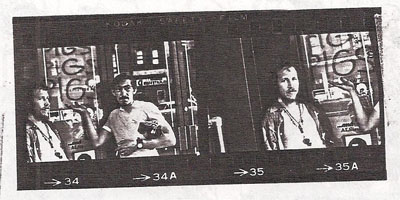
[...] As soon as classes [in Philadelphia] were finished I packed up my stuff, stuck it in a U-Haul and stowed it at Frank's apartment on Thompson St., around the corner from the Garrick. Frank was never there, so he didn't care but Gail was none too thrilled when she arrived from California to find that Redondo had eaten her parakeet. So I found a place on 25th st. and moved in and tore the plaster off the walls.
At the end of April 1967 I was in Pomona, California finishing my sophomore year in college when Frank called me from New York and said, "Hey, do you want to come work for me this summer?"
[...] I mentioned my friends Bill Harris and Dick Barber, whom Frank knew from our days in Claremont in the early 1960s.
[...] When I finished my sophomore year in college that June, Bill, Dick, and I set out for New York in a friend's VW Beetle. [...] We left L.A. early one morning in mid-June with little money and unrealistic expectations.
[...] We went looking for Frank's apartment. We found the building on Thompson Street.
[...] Frank said, "You can start work by coming to the show and you'll stay at Calvin [Schenkel's] apartment for tonight."
[...] Calvin's place was on 49th street. In those days, Hell's Kitchen was about as nice as its name implied.
[...] It didn't take long for Dick Barber to establish himself as a valuable asset to Frank and the band. His vast technical knowledge and mechanical skills were exceeded only by his calm, professional disposition. Frank realized that about Dick early in our time with him.
Bill [Harris] and I, on the other hand, weren't fitting into The Mother's organizational structure. [...] By the end of August, I told Frank that we would be going home.
I was working for [FZ] then, and he and The Mothers were doing a show in Greenwich Village. That's the year I realized I didn't have the temperament for the music business and made the hard decision to leave him in New York. We still stayed close for the rest of his life.
I was graduating from college and another lifelong friend of both of us, but particularly Bobby, a guy named Bill Harris, who went on to be a movie host on Showtime or one of the big cable television channels . . . anyway, Frank said to the three of us. "Hey, why don't you guys come and spend the summer here: I'll get you work—you can work for me or whatever." So we took somebody's Volkswagen Beetle and did a road trip from southern California to New York City. And we get there and Frank says, "Oh, Bobby and Bill: you're gonna be the ticket takers at the Garrick Theater," where Frank's band was playing five nights a week, right down on Bleecker Street. So I said, "Well what about me?" And he said, "Oh, we've got another plan: you're gonna help out this guy," who managed this place called the Cafe Au Go Go, which was similar to the Whisky A Go Go in LA, where all the new bands were playing.
I had been listening to jazz like Miles Davis and stuff, when I was throwing pots in college—me, artsy? Anyhow, I had only been in town for a couple of days, and I ended up being the assistant manager of the Cafe Au Go Go, not knowing what I was getting into. And I'm with Frank walking down the street, and Frank says, "Here, let me introduce you to somebody—he's playing this weekend: they play really loud, I think you'll like them." And here's this black guy with frizzed out hair, feather boas and concho belts and moccasins. And Frank says, "Hey, Richard—meet Jimi!" And I'm thinking, "Oh my Lord—what have I gotten myself into?"
And it was quite a weekend to see Jimi Hendrix in a tiny club, three nights, two shows a night. I called friends in LA and said, "You know what: I think this rock and roll's gonna get very big," watching the audience watch Jimi Hendrix.
[...] I recollect that Howard Solomon was the person who owned the property where the Cafe Au Go Go and the Garrick Theater were located. He was not actively involved in the Cafe Au Go Go; I think the guy I worked for was named Berry? I recollect that Howard Solomon and Herb Cohen were friends, which is how Frank ended up playing at the Garrick Theater and my connection to the Cafe Au Go Go.
[...] I think [Bobby] felt like he did not want to get into Frank's world. You know, he had quite a successful career in the publishing business—which is how he met Diane. And I think Frank knew that I was kind of business oriented, and I was not intimidated . . . I had met members of the band during the Studio Z sessions: I'd met Jimmy Carl Black and Roy Estrada and Ray Collins. And I was not offended by their—at the time—pretty terrifying appearance!
[JCB] was pretty terrifying for people: he was tall and always dressed in just jeans, with long hair . . . but he was the nicest guy. And I would say that was true of almost all of Frank's band members.
The Marines at the Garrick Theatre
One evening Dick Barber and I went out to Long Island to deliver some sound equpment that needed to be repaired. We found out later that while we were gone four Marines in their dress blue uniforms came into the Garrick.
Listen, we had three Marines in full-dress uniform on stage one night
with us.
I'll tell you the story. A Marine was killed in the Village, remember?
And there was a rumor that every Marine within shooting distance was coming
down to beat up everybody they found with long hair. The week following that
rumor, we're rehearsing in the theatre and in walk three full-dress Marines.
So I said, "Oh, hello there, why don't you come in and sit down."
I just went on with our rehearsal; we didn't pay any attention to them. When
we were done, they said, "We just bought your album and we really like
it." These kids, nineteen years old, stationed on the carrier Wasp at shore here, clean, you know? I said, "Well, I'm glad you do. Hey, listen,
how would you guys like to work with us a tonight?" They were really turned
on. I said, "Can you sing?" They said, "Yeah." "What
do you know?" "Well, I know, Everybody Must Get 'I Stoned and House of the Rising Sun. So we went across the street to have dinner;
I ate and they practiced their songs. Come back, we do this number. I said,
"Now look, there's one little thing I want you to do. When I give you the
signal, I want all three of you guys to lunge for the microphone and start screaming
'Kill!'" So we played like that "Archie" [Shepp], weirdness,
with the dissonant chords and all that, and on cue they ran right to the mikes,
started screaming "Kill!" The audience just went—they couldn't
handle it. Then when it was over, they clapped. So I said to the audience, "Thank
you"; and then Ray [Collins] says to the audience, "Thank you";
and then when I pointed to the Marines to have them say "Thank you,"
the first one walks up to the mike and says: "Eat the apple, fuck the core"
[i.e., Corps]. And everybody went, "Whew!" Oh wow. And then the second
one, he comes up and says: "Eat the apple, fuck the core." Point to
the third one; he goes up, he says: "Hey, you know, I feel the same way
as my other two buddies: Eat the apple, fuck the core. Some of us love our mothers
more." Full-dress blues, man—they just burned a dozen flags.
Court-martial city, all right? So then, we took an intermission
and they stuck around. I said, "Do you guys know . . . ?" "I
don't care, man. They can only get you once." All right, go back on. I
told Gail to get the doll. This is the first time we ever used the doll. We
had this doll that somebody gave us, it was really shitty—big plastic doll.
Bring it down and I say, "Hey, ladies an' gennlemen, the guys are, uh,
gonna sing Everybody Must Get Stoned." They go through all that shit and
I says, "Now, we're gonna have basic training. Uh, ladies an' gennlemen,
this is a gook baby; and the Marines are going to mutilate it before your very
eyes. Kill it!" Tossed it to them, they ripped the arms off, beat it up,
stomped on it, and just completely tore it apart. After they're all done, the
music got real quiet, the lights went down, and I held it by the hair and showed
the audience all the damaged parts of the doll's body, pretending. . . . There
was one guy in the front row, a Negro cat just come back from Vietnam, was crying.
It was awful and I ended the show there.
You know, "Thank you. Good-bye." It was an atrocity, it was
the most . . .
In our 5 month engagement in New York some of the things we did on stage were physically shocking. You know, not just saying things that some people might say were taboo. Some of the things that we did on stage really upset people, or made them cry. It disturbed them so that they were so wasted when they left there that they didn't know what had happened to them. Like the night that we had 3 full dressed United States Marines on stage.
[...] They volunteered to sing and I said, "Well, if you volunteer to sing, you will also have to take part in the show. When I give you the signal you lunge for the microphone and start screaming 'kill kill'." So they did—you know—and the audience thought this is really weird. After it was all over and they clapped I motioned to them to thank the audience. One Marine walks to the microphone and says, "Eat the apple—fuck the core," and the second Marine walks up and says, "Eat the apple—fuck the core," and the third one walks up and says, "Eat the apple—fuck the core—some of us love our mothers more." And nobody knew what to do. These guys were in full dress blues. They just burned the flag on our stage.
So the second half of the show we got this giant baby doll. We didn't show it to them. They were up there bopping around and having merry fun. They were a little drunk—you know—and doing the normal Marine Corp. fun time routine. I stopped the music and said, "Ah—we are going to have a little basic training. Boys and girls, this is a gook baby and the Marines are going to kill it for you." Here, and I threw it to them, "Kill this baby," and they ripped the piss out of it, stomped it, wasted the head—you know—just completely ruined it. We made crashing, smashing, noises on the instruments—you know—and the audience was getting nauseous. We quieted the music down and made it real sad and I held the doll up by the hair and showed the injured parts of the doll to the audience for ten minutes. Then we stopped and that was the end of the show.
And there was this guy in the front row that had just come back from Viet Nam that was beggin' us to stop all the way through the whole thing. That is an atrocity and can't record it—you know—because it doesn't come off on record. Live in person it is a very effective a—means of making people think a little bit about things that they tend to ignore.
During that summer, Greenwich Village was absurd. Any rumor, no matter how
stupid, could turn out to be true—so, at one point, rumor had it that a
hippie had killed a Marine.
Stories circulated that the Marines were going to come to the Village and kill
all the hippies. Everybody who was hippie-looking had their eyes peeled for
people who looked like Marines. Everyone figured they wouldn't really come
in dressed like Marines, so they were also on the lookout for anyone with hair
that was too short, or who had clean fingernails.
In the midst of this, we were working the Garrick, six nights a week, two shows
a night, and rehearsing in the afternoon.
[...] Anyway, we were in there every afternoon, rehearsing. One day, three Marines,
in full dress uniform, came through the door, sat down in the front row—and didn't say anything. I asked them how they were doing and, of course,
did they want to sit in?
I asked them if they knew any songs. One of the guys said that, yeah, they
knew "House of the Rising Sun" and "Everybody Must Get Stoned."
I said, "That's great. Would you guys like to sing with us tonight?
We'd just LOVE to have Marines singing on stage with us." They said,
yeah, they would.
I said, "Go across the street to the Tin Angel, have a few drinks,
and come back when the show is on."
When they came back, I brought them up on stage—although it must have
been against regulations for them to do this kind of thing in full dress—and
had them sing "Everybody Must Get Stoned." By that time they were
pretty well wrecked, so I suggested, "Why don't you show the folks in
the audience what you guys do for a living."
I handed them a big baby doll and said, "Suppose you just pretend that
this is a 'gook baby.'" They proceeded to rip and mutilate the doll
while we played. It was truly horrible. After it was over, I thanked
them and, with a quiet musical accompaniment, showed the ruined parts of the
doll to the audience. Nobody was laughing.
July 1-September 5, 1967—The Garrick Theatre
The question became, How far would they go? What could we get an audience to do? The answer seemed to be anything. We'd bring someone up and go, "Take your shoes and socks off, put your socks on your hands and lick them while we play." Anything we could think of. So long as the person telling them to do it was onstage, they would do it. The rest of the people in the audience were laughing at the person who was doing the most ridiculous things but saying at the same time, "I could do that! That could be me!" At a theater in New York, which had once been a porno theater or something, there was a projection booth at the far end of the stage. We ran a wire from there to the opposite side of the stage. We had pulleys on it.
Our drummer, Motorhead, was instructed to attach objects to the line at random times during the show and fly them down. When they would land onstage, whatever arrived, we would improvise on it. Once, he sent down a baby doll in a doggie-style position with its head removed. It flew over the audience, whizzing by like an apparition over their heads, and crashed into the post over us. It was followed shortly by a three-foot-long Genoa salami that sodomized the doll. It seemed to me that there was no reason to waste this perfectly good salami, so I invited this lovely girl with very long hair, wearing a kind of Little Miss Muffet costume, to come up onstage and eat the whole salami. We played and she ate the salami. She started to cry because she couldn't finish it. I told her it was OK, that we would save it for her and she could come back and eat the rest of it. She did.
July 4, 1967—The Garrick Theatre
We did have a stuffed giraffe rigged with a hose and an industrial-strength whipped cream dispenser. Under it we had a cherry bomb. That's how we celebrated the Fourth of July in 1967. Somebody waved the flag, lit the cherry bomb. It blew the ass out of the giraffe. Another guy reached behind the giraffe and pushed the button and had this thing shitting whipped cream all over the stage. That amused people for some reason.
[...] There's an art statement in whipped cream shooting out the ass of a giraffe, isn't there? We were carrying on the forgotten tradition of dada stagecraft. The more absurd, the better I liked it.
July 1967—Jimi Hendrix & The Mothers Of Invention
Special thanks to Charles Ulrich and Javier Marcote.
Tentative timeline
- July 3-4, 1967—The Jimi Hendrix Experience at Steve Paul's The Scene (New York debut).
- July 5, 1967—The Jimi Hendrix Experience at Rheingold Festival, Central Park, NYC.
- July 6, 1967—recording of "Burning Of The Midnight Lamp" at Mayfair Studio.
- July 7, 1967—Jimi Hendrix & Noel Redding see FZ using the wah-wah pedal with the MOI at the Garrick Theatre.
- July 7, 1967—Jimi Hendrix overdubs a guitar with a wah-wah pedal on "Burning Of The Midnight Lamp."
- July 9-16, 1967—The Jimi Hendrix Experience on tour supporting The Monkees.
- July 18, 1967—photo shoot for the cover of We're Only In It For The Money.
- July 19, 1967—recording of "Stars That Play With Laughing Sam's Dice" at Mayfair.
- July 21-23, 1967—The Jimi Hendrix Experience at Cafe Au Go Go.
- July 21, 22 or 23, 1967—FZ sees The Jimi Hendrix Experience for the first time.
- July 21, 22 or 23, 1967—Jimi Hendrix and Mitch Mitchell go upstairs to see The Mothers Of Invention at the Garrick Theatre. Jimi jams with the MOI.
- c. late July 1967—Jimi Hendrix and Buddy Miles visit the Zappa's house at Charles St.
July 7, 1967—Jimi Hendrix & The Wah-Wah Pedal
[Del Casher] persuaded Mr. [Joe] Benaron to let him record a demo to be given out in guitar stores to show what the wah-wah pedal could do. "They thought I was a crackpot, but they humored me," Mr. Casher says.
The record hit stores in February 1967. [...]
How did Mr. [Jimi] Hendrix learn about the pedal? From Frank Zappa, according to Mr. Casher, who says he had given him one.
Casher also began work on what would become the wah-wah pedal. "Dick Denney at Vox U.K. invented the original prototype, the midrange boost switch. When it was converted to transistors, they put a variable switch on it." Now that the midrange boost could be more precisely controlled, Casher had a flash of inspiration. "I thought, 'Let's put it on a pedal.' We got one from a Vox organ, and it fit very nicely. After I demonstrated it to all these engineers and music producers, everyone said, 'This will be the greatest thing—the trumpet players are going to love it!'"
[...] "I wanted to use it for guitar, but they said no. Everyone thought I was just a crazy kid," Casher says. [...]
But the wah was a hard sell, even to musicians who would later embrace it. [...] "I mean, my conventional people who I worked for, Gene Autry, Lawrence Welk, you know, the suits, I couldn't even try to use the wah with them—it was too weird, way out for them. I called Frank [Zappa] and said, 'I'm having a problem getting people to use it,' and of course he took one. He was playing it in New York, and Jimi Hendrix heard it and asked him about it, so we made sure he got one. In '67, Jimi was just getting started with his recording. He used it brilliantly, but it wasn't until Jimi played it in the rain at Woodstock that everyone just went crazy for it. The rest is history."
Off duty, Mitch spent his time trying to hear Gene Krupa play in a bar uptown and Miles Davis and Dizzy Gillespie in the village. Jimi and Noel went down to the village to see the Mothers of Invention at the Garrick.
Saturday, July 1—Tuesday, September 5, 1967: The Mothers Of Invention, Meredith Monk (only in July)
This show was held at the Garrick Theatre, upstairs the Café au Go Go. Friday night, July 7, JIMI HENDRIX AND BASSIST NOEL REDDING OF THE JIMI HENDRIX EXPERIENCE WERE IN THE AUDIENCE.
6 Thursday
New York City, "Mayfair Recording Studio Inc.," 701 Seventh Avenue—JHE studio recordings for "The Burning Of The Midnight Lamp." Noel: "Recorded new single again."
7 Friday
New York City, "Garrick Theatre," Greenwich Village—Jimi and Noel attend a Frank Zappa concert (who performed three shows). Frank Zappa: "He [Jimi] came over and sat in with us at the Garrick Theatre that night..." (Guitar Player, January 1977).
New York City, "Mayfair Recording Studio Inc."—JHE studio recordings. Noel: "Finished number."
John McDermott, Billy Cox & Eddie Kramer, Jimi Hendrix—The Complete Studio Recording Sessions, 1963-1970, 1996, p. 38-39
Where "The Stars That Play with Laughing Sam's Dice" came to life during these [June 28-30, 1967] Los Angeles sessions, the first traces of "The Burning of the Midnight Lamp" had appeared during the May 1967 sessions at Olympic [in London], when Hendrix toyed with the song's melody on the harpsichord stored in Studio A. A demo recording was made, and Hendrix took away a reel-to-reel copy for further study. In Los Angeles, Redding took credit for inspiring the song's introduction, as he remembers being intrigued with the sounds he had made playing a twelve-string guitar hooked up to a wah-wah pedal.
I think I was one of the first people to use the wah-wah pedal. I'd never even heard of Jimi Hendrix at the time I bought mine; I didn't even know who he was. I had used wah-wah on the Clavinet, guitar, and saxophone when we were doing We're Only in It for the Money in '67, and that was just before I met Hendrix. He came over and sat in with us at the Garrick Theater that night and was using all the stuff we had onstage. Seems like every time I went to Manny's there'd be some new gizmo that we'd try out, so we were always into the hardware of the rock and roll industry.
Allan Handelman's East Coast Live Show, WRFX, Charlotte, NC, January 11, 1992
John Scialli: Did you invent the wah-wah peddle?
FZ: No I did not. I was one of the first people to buy it and use it but I . . . The first wah-wah peddle I saw was a Vox wah-wah peddle that had on the bottom of it "The Clyde McCoy Wah-Wah Peddle'' 'cause I think they probably had to . . . they felt they had to license the idea of "wah-wah'' from Clyde McCoy who was a trumpet player who used to use a wah-wah mute on his trumpet. That was 1967 when I got that . . . but I did not invent it.
The Vox wah-wah promotional paper record, recorded by Del Casher, is dated
February 1967. This was recorded with the original, prototype wah. Working
back from that date, 30 days to figure production start-up (according to former
Thomas employees), puts possible creation of the wah in January of 1967, or
perhaps December of 1966.
Zappa and Hendrix didn't meet until July 7, 1967, long after Jimi's image was set and he'd released AYE? and made his US debut. Jimi also used a handcranked wah-wah prior to meeting or seeing Zappa, but it was indeed Zappa who introduced Jimi to the pedal version, and at the Garrick Theater.
Recording for "Burning" began on July 6, the evening before Hendrix and Zappa met. The basic track was probably finished on the 6th, then after his encounter with Zappa Jimi may have taken a wah-wah into the studio at Mayfair to experiment with on the evening of the 7th (I'm not sure Mitch and Noel were even present for the session, although Noel did attend the Zappa concert with Jimi—and in mid-1967, it was a bit unusual for even a JHE session to begin so late. Later of course it became standard, but I think this time he was simply inspired by his experience at the Garrick Theater to go in and play with the wah for a few hours.) The obvious thing to do, once he'd noodled a bit, was use the wah-wah as an effect on an actual song and "Burning" was just sitting there waiting for him.
Page 117 of Keith Shadwick's Musician, left column, a little over half way down:
"In between sessions, Hendrix and Redding checked out Frank Zappa at Greenwich Village's Garrick Theater, while Mitchell went to see Miles Davis and Dizzy Gillespie elsewhere in the Village. Hendrix immediately became fixated on Zappa's use of a wah-wah pedal for his guitar and used one the same evening for overdubs on the new single."
Frank Zappa admired Jimi, probably even more than Jimi admired him. Their first actual encounter took place in the summer of 1967, when The Experience returned to New York City after their success at the 'Monterey International Pop Festival.' Michael Whale reported for Melody Maker (22 July 1967) that on 7 July 1967, "Off duty, Mitch spent his time trying to hear Gene Krupa play in a bar uptown, and Miles Davis and Dizzy Gillespie in the village. Jimi and Noel went down to the village to see the Mothers of Invention at the Garrick."
Over the previous days, the Jimi Hendrix Experience had been recording "The Burning Of The Midnight Lamp", Jimi's first song in which he used a Wah-Wah pedal to great effect. According to Noel, Jimi had picked up this pedal in England during June, just before the Experience set off for America.
July 21-23, 1967—The Jimi Hendrix Experience at the Café Au Go Go
I thought Hendrix was great. But the very first time I saw him I had the incredible misfortune to be sitting real close to him at the Au Go Go in New York City, and he had a whole stack of Marshalls and I was right in front of it. I was physically ill—I couldn't get out, it was so packed I couldn't escape. And although it was great, I didn't see how anybody could inflict that kind of volume on himself let alone other people. That particular show he ended by taking the guitar and impaling it in the low ceiling of the club. Just walked away and left it squealing.
Bruce Hampton, interviewed by Rob Turner, Jambands.com, June 2000
We went out one night to hear Jimi Hendrix, and [FZ] was supposed to be on the guest list, and he wasn't, and he never used his ego and insist that he should have been on the guest list or anything. He just paid for himself and me to get in and never said a word. He just always showed class all the time.
[...] We saw Hendrix stick his guitar up through the roof. His guitar was moving back and forth with the strings hittin' it. It was quite amazing. I had no idea who the guy was, and Frank took me to see him. He was in a little club; it was called The Dom. Richie Havens was the closer, and Hendrix was the opener, it started at seven in the evening, and Richie came on at about nine o'clock. It was like a dollar and a quarter.
Frank said he wanted me to go to a club with him so I could hear this guy play guitar. I agreed. When we neared the club I heard this thundering sound coming out of the place even though the door was closed. I touched the door handle to open it and it was literally vibrating.
We walked inside and there were three guys playing on a small stage, making more noise than I'd ever heard in my life. When I use the word "noise" I mean it in the most positive way. I looked at Frank and smiled my approval and Frank yelled in my ear, "This guy's going to be the next Elvis Presley." He was referring to his growing popularity not the sound. "What's his name?" I yelled back. "Jimi Hendrix! His name is Jimi Hendrix!"
After seeing and hearing Hendrix on that muggy afternoon in the Village Frank took me to the Le Figaro Cafe nearby to introduce me to Jimi, but when we got there Hendrix was already at a table with two or three girls and otherwise occupied. The place was pretty empty so even from across the room you could see everybody who was in the place. At one point Hendrix looked up and caught sight of Frank and me and acknowledged Frank's presence with a smile and a wave. He was so loaded, that at best, it was a half hearted attempt to be cordial. I told Frank it was ok and that it was obvious that he was in no shape to meet the likes of me or anybody else at the time. "It's cool Frank," I said, "I don't think he needs to be interrupted right now." Frank agreed and we left the Le Figaro and I carried away my memory of Jimi Hendrix, Frank Zappa and me, on that hot muggy afternoon in Greenwich Village, New York in 1967.
c. July 21-23, 1967—Jimi Hendrix with The MOI at the Garrick Theatre
HENDRIX THEN RETURNED TO THE GARRICK, THIS TIME WITH HIS OTHER EXPERIENCE'S BAND MATE DRUMMER MITCH MITCHELL, ON JULY 21 OR 22 OR 23 (NO ONE REMEMBERS THE EXACT DAY!). JIMI AND MITCH WATCHED THE SHOW AND AT SOME POINT ALSO SAT-IN TO JAM WITH FRANK ZAPPA'S BAND.
[I played with Jimi Hendrix] twice. We (the MOI) used to work at a place called the Garrick Theater where we played 2 shows a night, 6 nights a week in a 300 seat theater. This was in 1967 and we were there for about four or five months. And, we used to have people come in and play with us on stage. And one night, working at a club right next door called the Cafe A-Go-Go, we invited him to come and play with us. So he went on stage and played at that event and also, a few moths later we were working together at a pop festival in Miami. I guess we were there for about a week and one night, after the daytime events, there was a jam session in a bar of a motel called Castaways. Those were the two times.
Kees de Lange, "Mr. Satire & Mr. Phenomenon," UniVibes #27, December 1997
On 24 February 1986, UniVibes subscriber Alain Chauvat interviewed Frank Zappa and asked if he ever played with Jimi Hendrix. Zappa replied . . . "I played with Hendrix twice . . . One night he played in a club right next door called the Cafe Au Go Go [21-23 July 1967] and we invited him to come and play with us. So we shared the stage that time . . . And there was a jam session in Miami."
Mitch Mitchell in his book The Jimi Hendrix Experience . . . "We did a couple of nights at the Cafe Au Go Go. I remember that because Zappa and The Mothers were in the upstairs bit, the Garrick Theater . . . I sat in with them once and I think Jimi may well have too . . . " (Pyramid Books, London, 1990, p. 69). (Note . . . There was a corridor between both venues.)
[Jimi Hendrix] sat in with us at the Garrick Theater. In fact, he played my hollowbody through a Fender Twin and got feedback out of that. All I know is he was working downstairs at this place. The Cafe Au Go Go, and we invited him to sit in and he came upstairs and I let him use my guitar and he got feedback and went ape. I saw him at the Cafe Au Go Go when he played with us and at a pop festival in Miami where we worked with him. [...] Yeah, I think he was good. I enjoyed playing with him. He also came over to the house one time with Buddy Miles and he said, "Hi, this is my friend Buddy" and I said "Great, pleased to meet you Buddy" and Buddy says "Hi, Frank" and sits down on the sofa and nods out. His head went back, his mouth fell open and he was snoring for two hours while I continued to talk with Jimi.
On another occasion, Jimi Hendrix sat in with us. I didn't know him before
then, and I can't remember how I was introduced to him—probably met him at
the Tin Angel. A few days later he came to visit our cubicle on Charles Street
with his friend, drummer Buddy Miles. Jimi was wearing green velvet pants—all decked out—on his way to a party with Buddy. (The only thing that Buddy
said was "Hi, Frank," after which he sat on the couch, leaned
back and passed out, snoring.) They were there for about an hour and a half.
Buddy had a nice nap, and Hendrix ripped his pants at the crotch while demonstrating
a dance step. Gail sewed them up for him. When it was time to leave he said, "Come on, Buddy." The snoring stopped, and they left.
July 1967—Meredith Monk with Don Preston
Saturday, July 1—Tuesday, September 5, 1967: The Mothers Of Invention, Meredith Monk (only in July)
This show was held at the Garrick Theatre, upstairs the Café au Go Go. [...] Also, in the month of July, American composer, performer, director, vocalist, bassist, drummer, filmmaker, and choreographer, Meredith Monk, opening some shows of The Mothers, backed by The Mothers' electric organist Don Preston. One of Monk and Preston's shows were also recorded and a song titled "Candy Bullets And Moon" was released as a one-side single that year, credited to Aunt Jamina and The United Pancakes (!!).
Denny Walley
[Denny] Walley played his first gigs while still in high school [back in New York], alongside bassist Tom Leavey (his future brother-in-law). They continued after graduation, spending most of the 1960s performing at clubs in and around New York and touring nationally as the Detours. "I'd lost connection with the Zappas," says Walley. "The next time I saw Frank was when I was playing with the Detours in Greenwich Village. It was the same time that Frank was playing at the Garrick Theater. I went over and saw Bobby Zappa in the lobby. I told him I'd love to see Frank."
The Village at that time was an epicenter of late-'60s counterculture. The vibe was heavy, and Zappa was an established figure. Walley went to visit him still dressed for work with the Detours—tuxedo, cufflinks, pinky ring—in other words, clean-cut and square. He didn't look cool—and Zappa didn't even know he was a musician. "I went upstairs and saw Frank," Walley remembers. "He was with Allen Ginsberg, Tuli Kupferberg from The Fugs—all these deep thinkers. I walked in and said, 'Hey Frank, remember me?' Oh God, was that awkward."
Ian Underwood
Underwood was a recent graduate of the University of California in Berkeley, with a master's degree in composition, when he saw the Mothers at the Garrick that summer. "I had no idea who they were, and there were about ten people in the audience," he says now. But what he saw and heard—"Varèse, Stravinsky, and the long jazz tunes, the pop numbers and satires, the jumps from complete randomness to organized sound"—inspired Underwood to go up to Zappa after the show. "I said I'd like to play with him." Zappa told him to be at Mayfair Studios, where Money was in progress, the next day.
When he got there, Underwood says, "there was nobody else there. There was something he had recorded that he wanted me to put keyboard parts on. There is a piano introduction"—he hums the opening of "Let's Make the Water Turn Black"—"that was one of the first things I did. It wasn't written down. Frank said, 'What would you do on this?' I did something—and there it is."
I had graduated from the master's program in composition from the University of California at Berkeley. Then I was in New York, unemployed. I happened to drop by the Mothers performance at the Garrick Theater. I had never heard of the Mothers; this was the first time I had any exposure to them at all. But they were doing just the kind of thing I was interested in. It wasn't just classical, it wasn't just jazz. And there was a lot of humor. In those days, Ray Collins and Motorhead Jim Sherwood were doing a lot of interplay. They had their own routines, which were mostly made up at the time.
I hadn't really hit on any work at that point, so I simply went up after the show, told Frank that I liked it very much, and wondered if I could play with them. Frank said he was interested. He asked me to come up to the recording studio, which was in midtown on the west side [Mayfair Studios, 701 7th Av, NYC]. I did, and Frank hired me because I could play keyboards and woodwinds, and I could read. At that point, nobody in the band was an accomplished reader, although Bunk Gardner could read. But I was able to let Frank hear the notes he wanted to hear. Plus I had a background in jazz, so I could improvise. So I fit in.
[...] I didn't have any keyboards of my own when I joined the band. Don Preston was playing Rhodes and Minimoog, so we would spell each other on those. I think we also got a Kalamazoo organ, which I played onstage and on the recordings.
Calvin Schenkel, Cal Schenkel Magazine, September 1981
When Ian joined the group Frank needed some new publicity photos so I took these one night in his Thompson St. apartment with a nikon and a bare lightbulb

[The Rolling Stones' Flowers was released June 26, 1967]
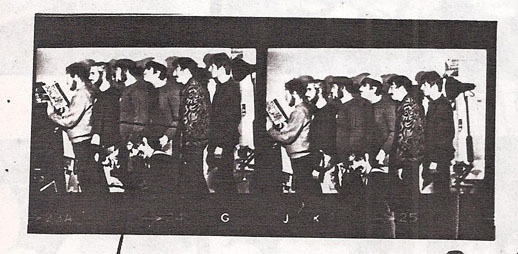
[Don Preston, Bunk Gardner, Billy Mundi, Roy Estrada, JCB, Ian Underwood, FZ; no Ray Collins]
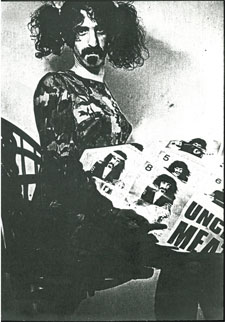
IAN UNDERWOOD—all keyboard instruments, saxophone, clarinet, flute and guitar—has an M.A. in music and was a child prodigy at the piano. He joined the Mothers in September of 1967.
August 16-19?, 1967—Promotional Trip—London, UK
Around August, we were only doing about three nights a week. We had cut it down to Thursday, Friday and Saturday because the rest of the week we were in Mayfair Studios recording a bunch of the new material for We're Only In It For The Money. Herb and Frank took a four-day trip to London and started setting up the press reviews for our first European tour which was going to be in September.
Pauline Butcher
The day I met Frank Zappa began like every other day over the previous five years. [...] On that dull, drizzly August afternoon in 1967, I had no idea.
[...] On that particular day, 16 August, [...] when the telephone rang I answered it. The concierge said, "Royal Garden Hotel here. We have a client who wants a typist at six-thirty. [...] It's for Mr. Zappa. Room 412."
[...] Mr. Zappa said, "What I want you to do is type the lyrics from the tape. I need them by tomorrow."
[...] Tom Wilson, Mr. Zappa's record producer, had just arrived, it seemed, after a delayed flight.
The Toilet Poster
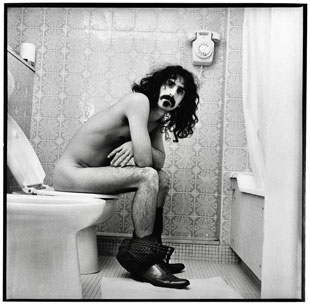
Photo by Robert Davidson.
I was asked to take publicity pictures of Frank Zappa [...]. I was invited to go and take pictures of Frank at the Royal Garden Hotel in London—it was a press call, there were 10 photographers, 25 reporters, all into a tiny room, very hot day. He was talking, and as he entered the room, I knew I was in the presence of someone exceptional. One of the three greatest men I've ever met.
[...] He goes to the lavatory and dissapeared—it was a very hot day, he had already taken off his top. And I'm the sort of person who just follows. Two minutes later I followed him to the bathroom [...]. He dissapeared round the corner to the bathroom. I followed two minutes later. And the bathroom door was open. He was sitting on the lavatory doing what everybody does and also he was talking to his wife, Gail, on the telephone—it was a very expensive London hotel. And the door was open, he was sitting naked, and I walked thus and went, "Ah! There is the best picture I have ever seen!" So I said to him, "Frank, please, may I take a picture of you?" And he said to Gail, "There's some limey here who wants to take a picture of me sitting on the john." I'm sure he didn't sound like that. And he said, "Yes, that's fine." So, I took the picture.
I had no idea there was ever gonna be a poster. That picture was taken in a toilet in the Royal Garden Hotel in London and it was part of a publicity campaign for our first appearance in England. And so, the guy that took it just decided to make a poster out of it. And due to the copyright laws in England, the photographer owns the photographs. Here, the photographer owns the photograph, but he doesn't own the right for your image on it unless you give him a release. There they don't need a release, so he took the thing and went out and made a poster out of it. Well, it pissed me off, and I couldn't do anything about it, because they had a whole bunch of them on the market. And it's probably one of the best-selling posters of all time, although I haven't seen any money at all from it. It's bootlegged all over the place; somebody makes a poster of it, somebody else'll take a photograph of that poster and print up his own. There are two or three different varieties of it that are circulating all over Europe.
I met [Bobby Davidson] in 2006 at the Mighty Baby concert at the Borderline. He knew the band when they were the earlier 'The Action'. He lost out as he claimed to me that Zappas bodyguard took the rolls of film. He might be referring to Herb Cohen.
Rock and roll photographer Robert Davidson [...] claims he was strong-armed out of a set of iconic rock pictures almost 50 years ago [...].
The poster picture of US rocker Frank Zappa sitting naked on a lavatory has adorned posters, T-shirts and mugs since it was taken by Mr Davidson in a London hotel room in 1967.
Yet Mr Davidson has hardly made a penny from it, after, he claims, he was forced to hand over the negatives to Zappa's manager following a mix up over royalty payments. A year ago he managed to buy them back on eBay for just £66.
August 17, 1967—FZ introduces Cream at the Speakeasy
After a day of interviews and discussions on [August 17], Frank renewed his acquaintance with Eric Clapton, Jack Bruce and Ginger Baker, who were playing at the Speakeasy, a members-only basement club popular with musicians and record business 'heads'. Nick Jones reviewed the night in the August 26 Melody Maker. "The late-night looners have favoured the Speak's environment because as boss Mother Frank Zappa so quickly realised, 'the vibrations are groovy'. And that's how Zappa introduced 'this dandy little combo', otherwise known as the Cream, to a club full of Speak-goers last Thursday."
As he helped me on with my jacket, he said, "Some of us are going to the Speakeasy real soon. How would you like to be my date?" [...] A line of people queued along Margaret Street and around the corner to Oxford Circus, but someone ushered us straight down the stairs into the black interior [...]. Procol Harum's "Whiter Shade Of Pale" came on and Frank asked me to dance. Strangely, everyone else sat down and we were alone, as if performing some kind of cabaret. [...] I caught words passing down the line, "That's Frank Zappa." [...] At last, the final chords of the record faded away and with relief, I stumbled back to the table giddy from so many twirls.
Still wearing his coat, Frank dropped beside me. Out of the gloom a figure with a mop of hair and long sideburns appeared. "Frank, Frank, great to see you, man."
Whoever this was, he pulled up a chair.
Frank turned to me, "Pauline, Eric Clapton, Eric, this is Pauline Butcher."
I shook his hand, and leaning forward like a benevolent music teacher, asked, "And what do you play?"
His eyes slithered to Frank, then back at me. He came close to my face and said confidentially, "I play the guitar."
"That's nice," I said.
[...] I could hear Eric telling Frank about his forthcoming gig at the Fillmore in San Francisco. Frank warned him about flower-power. [...]
Eric asked Frank to introduce their band shortly and Frank agreed. Then he disappeared into the murky gloom.
Frank turned to me as I re-surfaced. "Where have you been hiding, Pauline? Don't you know who that is?"
"No, I don't."
"Your country's best rock'n'roll guitarist."
September-October 1967—1st European Tour
Departing From The Garrick Theatre
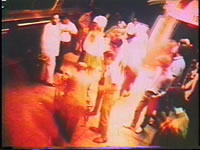
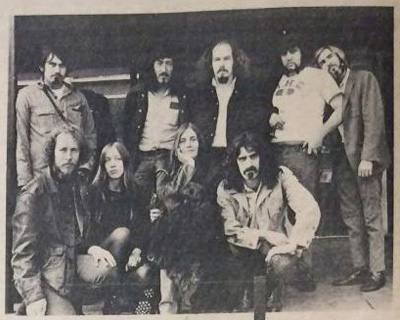
[Roy Estrada, Don Preston, Sandy Hurvitz, JCB, Pamela Zarubica, Ray Collins, FZ, Billy Mundi, Bunk Gardner; photograph probably by Paul Campbell.]
MOTHERS OF INVENTION FLY IN
The Mothers of Invention, with two Suzy Creamcheeses on board, arrived at London's Heathrow Airport on Monday. The group play at London's Royal Albert Hall on Saturday (23) with the London Philharmonic Orchestra and are spending the week in rehearsals.
Charles Ulrich, July 16, 2013
That photo (with Ray Collins revealing his belly button) is in Russo's Cosmik Debris and two Miles books (Visual Documentary and In His Own Words). Both Miles books credit it to Paul Campbell.
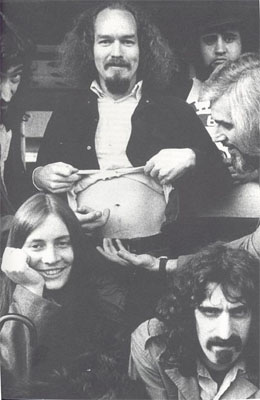
I was with the Mothers in 1967 when we did the first trip to London, and that was when they officially put me into the band. I was taking care of the equipment, and they couldn't decide if they wanted me as equipment manager or as a musician in the band, so they decided to make me a musician who took care of all the equipment.
Everything was arranged for our first European tour. Billy Mundi and I left Woodstock on 13th September and everybody met at Frank's place on Charles Street.
Besides all the guys in the band, there was Dick Barber, Sandy and Pamela, Herb and his wife Suzy, Howie Solomon and his wife, and Tom Wilson. They'd chartered a bus to take us to the airport with all our equipment. Dick Barber was now officially our road manager and he had quite a job because it was quite an entourage. Fifteen of us went to Europe.
Heathrow Airport, London, UK

London Airport 1967 (Press Association LTD) [Motorhead, Ian Underwood, Don Preston, FZ, Bunk Gardner, Pamela Zarubica, Billy Mundi, JCB, Roy Estrada, Ray Collins]
Calvin Schenkel, Cal Schenkel Magazine,1981
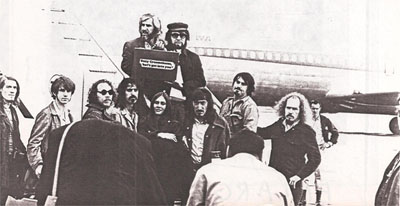
[Motorhead, Ian Underwood, Don Preston, FZ, Bunk Gardner, Pamela Zarubica, Billy Mundi, JCB, Roy Estrada, Ray Collins]


London, September 1967
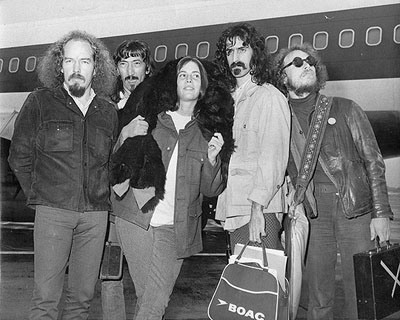
[Ray Collins, JCB, Pamela Zarubica, FZ, Don Preston]
A paper label on the back of this photo states
"They are shown on arrival from New York at Heathrow airport, London, today (Monday). From left to right, they are, Mothers, RAY COLLINS, JIMMY CARL BLACK, SUZIE CREAMCHEESE (the only one capable of motherhood), the group leader, FRANK ZAPPA and DON PRESTON. [...] September 18th 1967 PAP 130138-1 (Hm-O) PRESS ASSOCIATION PHOTOS"
London
The Mothers of Invention arrived on 18 September. A photograph in the Evening Standard showed a hairy bunch with a girl, Suzy Creamcheese, standing among them. The journalist asked Frank, "Is she your girlfriend or something?" Frank replied, "Or something."
Frank and Herb went to London on an exploratory trip to set up the first European tour. Boy, was I surprised to learn that I was going on the tour as official photographer. We rented a Nikon and a Hassleblad (which I never used). Meanwhile the original "Suzy Creamcheese" arrived in New York for much the same reason, to accompany The Mothers as spokeswoman or something. Europe was a lot of fun and I didn't work very hard, but I didn't get paid either, which was a general point of disagreement between the entire entourage and Hurby. I got pissed off because of this and decided to stay in Denmark when the group came home. Alas I soon ran out of Kroner or whatever the hell they use there and came home myself (but not before getting lost hitch-hiking through Germany—another story).
We never did shows that duplicated records or other gigs. Originally it was almost free-form; you never knew what was going to come up. Then, just after I joined and we started touring Europe, we began getting larger audiences. This meant that they couldn't be as close to us, so the kinds of off-the-wall things that would be easy to get into at the Garrick Theater really wouldn't work anymore. You couldn't do something free-form that might not work when you've got a lot of people who have paid money to listen to you. So, more and more, a balance was struck in favor of being more organized, based on doing things that were more likely to work consistently well. Then, if other free things came along in the middle of those pieces, that would be okay too.
This didn't drastically change the way we worked, but we did start having more music to rehearse. Sometimes there would be different arrangements of tunes that the Mothers had done earlier. Then there were new, classically-oriented pieces that Frank would bring in. They were pretty complicated, but they weren't different in kind from what we had done before. There was more of a difference in scale and amount, because Frank always loved to write this way.

[Billy Mundi, Ed Seeman (prob.) Ian Underwood, FZ, Don Preston, Pamela Zarubica, JCB, Roy Estrada.]

[Bunk Gardner.]

Foto di Gabria Belloni
Suzy Creamcheese
A lot of people identified with Suzy Creamcheese and then when we were ready to go to Europe the first time, we discovered that people there were more interested in seeing Suzy Creamcheese than they were in seeing us. Not quite, but it was at a hysteria peak in certain areas. So we decided that it would be best to bring along a Suzy Creamcheese replica who would demonstrate once and for all the veracity of such a beast. So, I checked around to see who would be willing to go along with the gag and, uh, Pamela [Zarubica] was willing and, uh, she was available and . . . [...] Anyway, there was no way to get a hold of Jeannie Vassar and, um, Pamela was available and was interested in the concept, so I said, "Okay, here's your ticket, come on." And so she did the tour with us in Europe and has maintained the title ever since.
FZ, interviewed by Andy Gill, Q, December 1989
That little story on the Freak Out! album was just something I made up, and shortly after that I had people coming up to me in droves introducing themselves as Suzy Creamcheese. When we did our first British tour, we had a specific request—from the British promoter, I believe it was—that we manifest some sort of Suzy Creamcheese on the stage. So I hired a girl named Pamela Lee Zarubica to be Suzy Creamcheese. All she did was sit on the stage when we played the Albert Hall—didn't do anything!
Frank called me and said
that there was a great desire to see Suzy Creamcheese because the people in
Europe couldn't imagine what kind of a chick to associate with the picture
they had seen of these guys [...]. He said, "I'm going to Europe
and they want Suzy Creamcheese, you come and stay with Gail," and I said
"Come and stay with Gail? I am Suzy Creamcheese and I'm going with you
because if you take some asshole who doesn't know how to talk to the press
[...], that doesn't know how to talk to people, you're never going to
talk to anybody, period."
Calvin Schenkel, The Big Note, Yahoo Groups, July 18, 2006
I met [Pamela Zarubica] when Frank took her to Europe on the first tour as Suzy Creamcheese (I went along as photographer.) We hung out together, mostly when everybody else was at rehearsal. And then in NYC when we got back she stayed at Charles St., this was just after Moon was born, she & Gail were pretty good friends at the time. She lived at the log cabin for a while too & my friend jeff tried to jump her bones but I don't think she went for it. Haven't seen her since around then. I heard she was in London.
Preparations for the European tour included summoning Pamela Zarubica, herself just back from her prolonged stay in Europe during which she'd become pregnant, to look after Gail while Frank was away. [...] When Pamela learned that Frank had been asked to bring along Suzy Creamcheese on the tour, she made it very plain that the role was hers. Herb Cohen didn't like the idea much but Pamela, and thus also Frank, was adamant.
September 23, 1967—Royal Albert Hall, London, UK
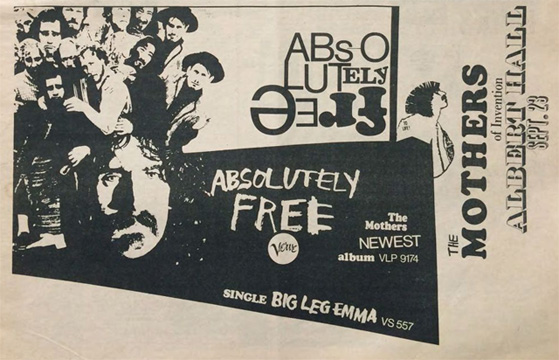
"NOW we're gonna play," said Frank Zappa, "and you're gonna clap and then I say 'now let's roll along a little' and we'll play some more and then you'll clap and we'll play some more and then we'll go home and the war will go on and stuff."
At London's Albert Hall on Saturday the Mothers of Invention proved it is possible to break every rule in the book and still emerge as probably the best rock group to play in Britain since the Beatles made "She Loves You." They put down or send up everything: flowerpower, America, the Mothers Of Invention, the audience, their music.
Because one thing shone through which could not be put down even despite Zappa's attempts; musically, the Mothers are nothing short of incredible, and their show so well rehearsed and put together.
The concert included several ill-at-ease members of the London Philharmonic Orchestra, masses of amplifiers, two drumkits, kettle-drums, amplified trumpets and horns, and at one point a scrawny, long-haired Mother leapt up through the audience and played the Albert Hall's majestic grand organ. He played it beautifully, too.
The concert was a series of grand build-ups towards what Zappa called "big teenage climaxes;" they never reached the last one, so that after several minutes Zappa suddenly said good-bye, the Mothers disappeared from the stage and the astounded audience slowly realised the concert was indeed over and drifted out in a state of considerable tension. Outside the hall, Kensington looked very strange.
I joined the crowds shuffling into the Albert Hall. [...] Someone near my seat in the raised section at the side pointed to the front stalls and said, "There's Jimi Hendrix and Jeff Beck."
[...] Then [FZ] introduced ten musicians from the London Philharmonic Orchestra who wandered on looking embarrassed.
[...] When one of the Mothers climbed the walls to the mighty Albert Hall organ and played the opening strains of "Louie, Louie," the audience erupted.
[...] Suzy Creamcheese stood to the side tapping a tambourine. [...] At one point, she spoke out the words to "Mellow Yellow" and later, when the orchestra played chamber-like music and some people slow handclapped, she said into the microphone, "Maybe you're not ready for this kind of music yet."
[...] Frank swivelled round to Calvin [Schenkel]. "Did you get some good shots?"
"During the concert? No."
Frank turned further in his seat to check he'd heard correctly.
"I was hungry. I went out to eat," Calvin explained.
"You went out to eat?"
"Yeah."
I expected Frank to explode. Instead, he raised his eyebrows and said quietly, "I brought you three thousand miles to do one fucking thing—take photographs of the show—and you go out to eat? How long does it take to eat?"
"We couldn't find anywhere. It took a while."
Jimi Hendrix and I once went to the Royal Albert Hall to see Frank Zappa and The Mothers of Invention. During the intermission, we spotted Brian Jones up in one of the boxes, and we wanted to go and get high with Brian. So, we got up from our seats, and we started to move along the seats and a spotlight found us. Now, quite frankly we were both on acid, so this bright light hitting us in the face when we thought that we were invisible was quite shocking to us, but we managed to make it all the way to Brian, to the box that Brian was in, and we managed to get higher than we were.
Eric Clapton, Clapton: The Autobiography, 2007, p. 238
I remember when the Royal Albert was off-limits to rock music, and somehow The Mothers Of Invention managed to get booked there. It was a fantastic show, and for an encore Frank Zappa's keyboard player, Don Preston, known as "Mother Don," broke into the hall's organ keyboard, which was locked behind two glass doors, and played a raucous version of "Louie Louie" that brought the house down.
Kees de Lange, "Mr. Satire & Mr. Phenomenon," UniVibes #27, December 1997
Jimi [Hendrix] had not missed the chance to see The Mothers perform. As was reported in the issue of Disc and Music Echo of 30 September 1967 . . . "Jimi Hendrix dug Zappa's guitar-playing at London's Albert Hall." What's more, when Zappa noticed Jimi entering the venue, he immediately went into a parody of "Hey Joe" (or "Flower Punk" perhaps?).

[Bunk Gardner, Ian Underwood, Don Preston; Roy Estrada, FZ, Billy Mundi; Ray Collins?, JCB.]
(center right: rehearsal at Albert Hall)
September 24, 1967—Concertgebouw, Amsterdam, Netherlands
This was the first show after London, where Zappa had gone out and bought an all-new set of Marshall equipment right after they'd been paid (no credit for weirdos—cash only). There was a lot of testing-out going on, always so much more interesting than the concert, to me. Very enjoyable afternoon . . .
They knew the score: First thing they asked us upon arrival in the Concertgebouw was Where's the Vondelpark? so they could go score some dope, as easy there as in San Francisco. Luckily, that was only two or three blocks away.
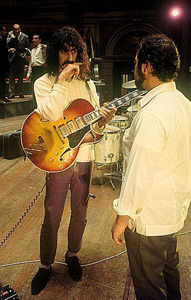
[FZ, Herb Cohen. Photo by Harrie Verstappen.]
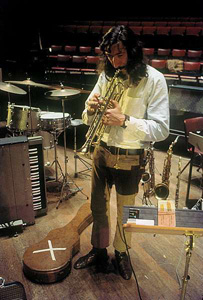
[JCB. Photo by Harrie Verstappen.]
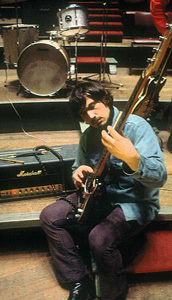
[Roy Estrada. Photo by Harrie Verstappen.]
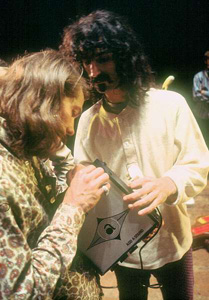
[Motorhead, FZ. Photo by Harrie Verstappen.]

[Bunk Gardner, Ian Underwood. Photo by Harrie Verstappen.]

[Don Preston, Billy Mundi. Photo by Harrie Verstappen.]
I took the photographs for Paul Acket's Tiq magazine, that later published my work with Yayoi Kusama. But just like those of the Kinks they were way too far out for his taste, even for Tiq! Hard to imagine now, I agree. So below I show you the photograph by Rob Bosboom he did publish, so we both know what I'm talking about.
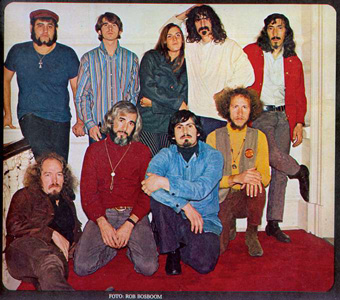
[Billy Mundi, Ian Underwood, Pamela Zarubica, FZ, JCB; Ray Collins, Bunk Gardner, Roy Estrada, Don Preston. Photo by Bob Bosboom.]
September 1967—Hamburg
The first news conference I ever went to was in Hamburg, Germany
at the press club which is at the top of a skyscraper overlooking the . . . [...] Oh god, that was ridiculous. [...] It was the first time we'd
ever been to Germany. They had movie cameras all over the place and people who
didn't speak English too good, and guys in the band who didn't speak German at
all. And these people had no idea . . . . [...]
And I remember that because Don Preston had a little tiny deck of Tarot cards in
his pocket. And we were all sitting around answering obtuse questions from these
guys. And he zipped off to the side with one chick and he was telling her
fortune with these Tarot cards on the side. That's one way to get into a German
journalist's pants, with Tarot cards. Remember that if you ever go over there.
September 28, 1967—Moon Unit Zappa
Frank flew back to Copenhagen for the third European concert.
After that concert, just as they were about to leave for Gothenburg, news came through from New York that Gail had given birth.
67/09/27 Copenhagen
Denmark Falkoner Theatret
67/09/29 Gothenburg
Sweden Konserthallen, Liseberg
Then we flew to Copenhagen and we had four or five days off [...]. Frank and Herb flew to Italy for a meeting with Roger Vadim as he was making the Barbarella movie. There were some discussions about using some of Frank's music in the film.
We travelled to Gothenburg where we were meeting back up with Frank, to play the first gig in Sweden. [...] We played the gig and noticed that Frank wasn't feeling too good. He had eaten some food while he was in Italy and devoloped food poisoning.
The next day we flew to Stockholm and by this time Frank was getting really ill. [...] He played the first half of the show but he was so fuckin' ill that he couldn't go back on, so we went out and did the second part without Frank. [...]
The next day we flew back to Copenhagen to play at the Falkoner Theater. [...] [Frank] was very weak but at least he was OK. Motorhead was travelling with the gear and a Dutch truck driver we had hired. Something happened to the van. We got there in time for the gig but the equipment wasn't there. We ended up using equipment borrowed from John Mayall and The Blues Breakers. [...]
There was one more show left, so we took the ferryboat back across to Sweden and played at the University of Lund. We travelled back on the ferry, spent the night in the hotel and went to Copenhagen airport to fly back to London. That's where we met Peter Sellers, in the airport. [...] Then we flew on to New York and I went straight back out to Woodstock.
September-October 1967—Europe (probably Copenhagen)

[JCB, Pamela Zarubica, FZ.]
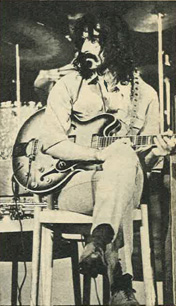
[FZ.]
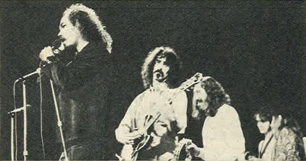
[Ray Collins, FZ, JCB, Ian Underwood, Pamela Zarubica.]
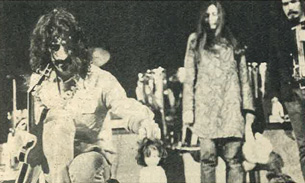
[FZ, Pamela Zarubica, Ray Collins.]
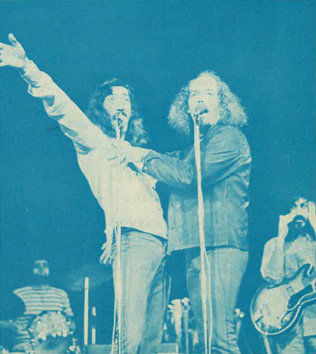
[Billy Mundi, JCB, Ray Collins, FZ.]
October 2, 1967—Akademiska Föreningen, Lund, Sweden


Frank Zappa och popgruppen Mothers of Invention på AF i Lund 1967 Akademiska Föreningen
Zappa-konserten 10 oktober 1967 ägde rum i Stora Salen på AF (Akademiska föreningen, WGS84 55°42'18.4'' N 13°11'43.5'' E) i Lund. Jag var själv där. MOI hade inte med sig någon sånganläggning, utan använde den som fanns i Stora Salen. Det visade sig att den inte alls fungerade för dem, den var gjord för föredrag. Så MOI gav upp sången efter en stund och spelade enbart. Det var två konserter efter varandra och jag var med på bägge. Det visade sig att bägge konserterna var mera en enda lång jam session. Scenen var mitt på långväggen mot Lundagård, inte upphöjd utan direkt på golvet. Jag pratade en stund med basisten Roy Estrada efteråt.
Google Translate:
The Zappa concert on October 10, 1967 took place in the Great Hall at AF (Akademiska föreningen, WGS84 55°42'18.4'' N 13°11'43.5'' E) in Lund. I was there myself. MOI didn't bring any vocal equipment with them, but used the one in the Great Hall. It turned out that it didn't work for them at all, it was made for lectures. So MOI gave up singing after a while and just played. There were two concerts one after the other and I was at both. It turned out that both concerts were more like one long jam session. The stage was in the middle of the long wall facing Lundagård, not elevated but directly on the floor. I talked for a while with bassist Roy Estrada afterwards.
Further evidence [of the date and venue] found at a record store in Malmö (close to Lund): poster stating as follows:
The Mothers of Invention
Stora salen, AF (great hall, Akademiska föreningen)
Måndag 2 oktober kl 18.30 & 20.30 (monday 2 october 6.30 pm and 8.30 pm)
The poster design is based on the album art from Absolutely Free.

Informants: PompeyNeil & jenshakan at Zappateers.
Suzy Zeiger (aka Suzy Creamcheese)
Barry Miles, In The Sixties, October 2002, p. 146-147
Suzy Creamcheese arrived from Los Angeles and got rooms at the White House, a short-let apartment hotel just by Great Portland Street tube station. Hoppy met her on the day the first issue of IT was published, 14 October [1966]. She telephoned the printers, looking for Donovan, but by the end of the day she was with Hoppy back at the White House. Suzy Creamcheese was a generic name that Frank Zappa gave to the group of Jewish girls, fans of the Mothers of Invention, who hung out at Ratner's Dairy Restaurant on Fairfax. The girls did publicity for the band, danced at the front of their gigs to get the crowds going, and performed other, unspecified services. The Suzy on the Freak Out record was Pamela Zarubica, who also moved to London, but the one Hoppy was to marry was Susan Zeiger, whose father owned the Zeiger ballrooms where the Mothers often performed.
Mystery always surrounded Suzy Creamcheese (née Zieger). [...] She did have these conservative parents somewhere in California, who were so appalled by her free-form lifestyle that they kept having her committed to various expensive mental institutions, causing Hoppy to array himself in a ninja outfit to break in and spend the night with her while she was so incarcerated.
Hoppy was energised when a unique woman dropped into his life in October [1966]. Fancy dress and flowers were second nature to Suzy Creamcheese (Susan Ziegler). In Los Angeles, she formed part of the auxiliary cadre surrounding Frank Zappa's Mothers of Invention at the Ziegler Ballrooms her father owned.
I can offer you a vaguely relevant anecdote. In the small and incestuous world of the London "underground" in 1968 or thereabouts, there was a fairly prominent American woman who called herself "Suzy Creamcheese" and claimed to be Zappa's original inspiration. Her real name was Suzy Zeiger. No-one was sure how true her claim was, so there was much interest when Zappa and the Mothers played the Albert Hall, and Suzy appeared in a prominent position in the audience.
Between songs, she shrieked. "Hi, Frank! It's Suzy", and the following dialog ensued:
"Suzy Zeiger?"
"Yeah!"
"You've got nice tits."
This was the same gig where the Mothers played "Louie, Louie", using the Albert Hall's own pipe organ, and were banned from playing there ever again.
Mitchell Harrison, "Suzy Creamcheese Weds Happy Hippie While Band Plays,"
Suzy Creamcheese, that happy American hippie in London, became Mrs. Hoppy Hopkins on her third attempt to marry the Old Rugbeian leader of London's Underground movement. [...]
Suzy Creamcheese, born Zieger, called queen of London's hippies, is a California export to the British Isles and had to promise to get married within a week so that immigration authorities would allow her to remain.
[...] Mr. and Mrs. Hopkins spent the first evening of their married life with Suzy's parents, Mr. and Mrs. Irving Zieger of Los Angeles, at the movies.
YouTube: Who is Suzie Creamcheese? (0:19 min.)
Informants: Bill Lantz, Charles Ulrich, Javier Marcote, Avo Raup
October-December 1967—East Coast
October, 1967—Nico & Kaleidoscope in New York
While in New York on our first trip, the Kaleidoscope was performing at The Scene, opening for Nico. We were staying at the Albert Hotel. In our first half hour in town we were robbed of some of our instruments—the van had been left unattended. The next morning I went out of the hotel to see New York for the first time. As I approached the corner, I saw a tall, longhaired guy in a full-length fur coat walking across the street in my direction. It was Frank Zappa, and he called out, "Hey, Chris, what are you doing here?" I invited him to our gig and he invited me down the street to the Mothers Of Invention's rehearsal hall. I had certainly arrived in New York! That night at the gig, Frank and some of his band showed for our set. He was so appalled at Nico's caterwauling that he got up after her set and went up on stage and got behind her Hammond organ. He proceeded to start pounding on the keys and screaming the names of vegetables. That was his interpretation of Nico.
Monday, October 23 - Saturday, October 28, 1967: Steve Paul's The Scene, 301 West 46th Street, Theatre District, Midtown Manhattan, New York City, New York
Also on the bill: Nico, Tiny Tim. The Kaleidoscope embarked on a six-week tour of the East Coast, and these shows at The Scene (originally scheduled from October 23 to 29) were only their second outside California.
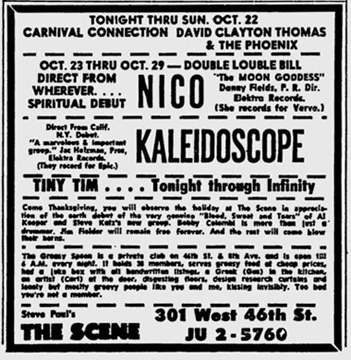
Village Voice (October 19, 1967)
The Kaleidoscope played Steve Paul's The Scene club in New York during December 1967 and Darrow has some unique accounts of this gig and encounters with Frank Zappa.
"I had just quit the Kaleidoscope due to musical differences and had nothing planned as my next move. Then I was asked by the band to join them on a tour to New York City. My replacement, Stuart Brottman, wasn't yet able to join the band since he still had some dates to finish up with Geoff and Maria Muldaur.
"I had never been to New York before, so I accepted the offer and insisted on flying as opposed to driving with the band in 2 VW Vans. We were to be staying at the infamous Albert Hotel in the Village and upon arriving to unload our equipment, the vans were left unattended and a number of our instruments were stolen from the vans, including my classic Fender Telecaster. Thankfully, I had brought my rare, Premier Bass on the plane with me and, from that point on, it never left my sight. As it turned out before I arrived, the band had been turned down at the Chelsea Hotel, even after having reservations, for being too scruffy and dirty by the establishment. I believe the term 'dirty hippie' was used more than once in their ouster. [...]
"My first day out on the streets of New York was very eventful, however. It was the beginning of December and it was very cold and brisk outside. I had just walked out to the street, when I looked across the intersection and saw a guy in a full-length fur coat and long hair coming my way. He was waving at me and said, 'Hey Chris, what are you doing here?' It was Frank Zappa, and he was on his way to his rehearsal hall down the street. I invited Frank to our gig and he invited me down the street to the Mothers Of Invention's rehearsal hall.
"I had certainly arrived in New York!
"Opening night was very crowded and Zappa and members of the Mothers of Invention showed up to show their support. There were very few west coast groups that had played in the east yet, and we 'long-haired hippies' were the antithesis of the New York vibe at the time. Warhol and his minions showed up, The Cyrcle was there, the Chambers Bros., Jim Fielder, Leonard Cohen and David Clayton-Thomas, pre-Blood Sweat and Tears were all hanging out.
"Our first set went fine and then it was time for Nico. I had met her in LA at Barry Friedman's (aka Frazier Mohawk) house, so I knew a little about her. I was never really a Velvet Underground fan or into the Warhol scene. In fact I just thought that most of it was bad, New York posing. Nico's delivery of her material was very flat, deadpan and expressionless and she played as though all of her songs were dirges. The German-born singer seemed as though she was trying to resurrect the ennui and decadence of Weimar, pre-Hitler Germany. Her icy, Nordic image also added to the detachment of her delivery. She was certainly beautiful, as Greta Garbo and Marlene Dietrich certainly come to mind. The audience was on her side, as she was in her element and the Warhol contingent was very prominent that night. However, what happened next was what sticks in my mind the most from that night.
"In between sets, Frank Zappa got up from his seat and walked up on the stage and sat behind the keyboard of Nico's B-3 organ. He was so appalled at Nico's caterwauling that he got up after her set and went up on stage and got behind her Hammond organ. He proceeded to start pounding on the keys and screaming. That was his interpretation of Nico.
"Frank placed his hands indiscriminately on the keyboard in a total, atonal fashion and screamed at the top of his lungs, doing a caricature of Nico's set, the one he had just seen. The words to his impromptu song were the names of vegetables like broccoli, cabbage, asparagus etc. This 'song' kept going for about a minute or so and then suddenly stopped. It later became 'Call Any Vegetable' off the Absolutely Free LP. He walked off the stage and the show moved on. It was one of the greatest pieces of rock & roll theater that I have ever seen!
"The New York scene and the west coast attitude were very different at that time. The hippie deal was counter to the atmosphere prevailing in most of the east at that time. Frank was a breath of fresh air in our cold, metropolitan environs. A few days into the gig, a junkie looking for a score stole a bunch of our equipment from the club, and Frank loaned us some of his amps and drum stuff so we could finish off the week stint at The Scene. During this time we learned one of our engagements had been canceled at The Café Au Go Go, so we booked a show at Fun City, a mob joint on 42nd Street. The dressing room had an autographed photo of Frankie Lyman on the wall, and the Go-Go dancers would start in the Fun City window around noon. Frank saved us!"
November 3, 1967—Eastern High School, Baltimore, MD
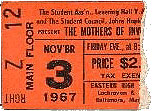
Michael Maltese, interviewed by Charlene Polk, The Daily Times, Salisbury, MD, June 21, 2007
[Maltese] enjoys reminiscing while looking at the old photos. "The first band I ever shot was Frank Zappa," he said. "It was a concert given at Johns Hopkins, but they performed in a high school auditorium because everyone thought it was too radical."
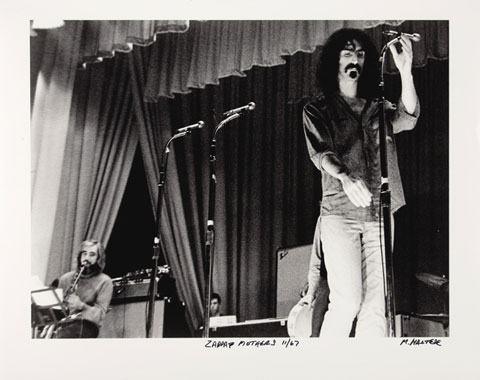
November 24-25, 1967—Psychedelic Supermarket, Boston, MA
When we were in Boston, several weeks ago, in a place, the worst fuckin place we ever worked, no maybe not the worst but pretty damn close to it. It is called Psychedelic Supermarket. It was what you call an unfinished club, with a very mediocre to say the best, PA system. We were forced to work there, so we did. A block and a half away is the Boston University Radio station with a disc jockey named Uncle T, running his show from midnight to 3 in the morning. He said come on down you guys and take over my show.





